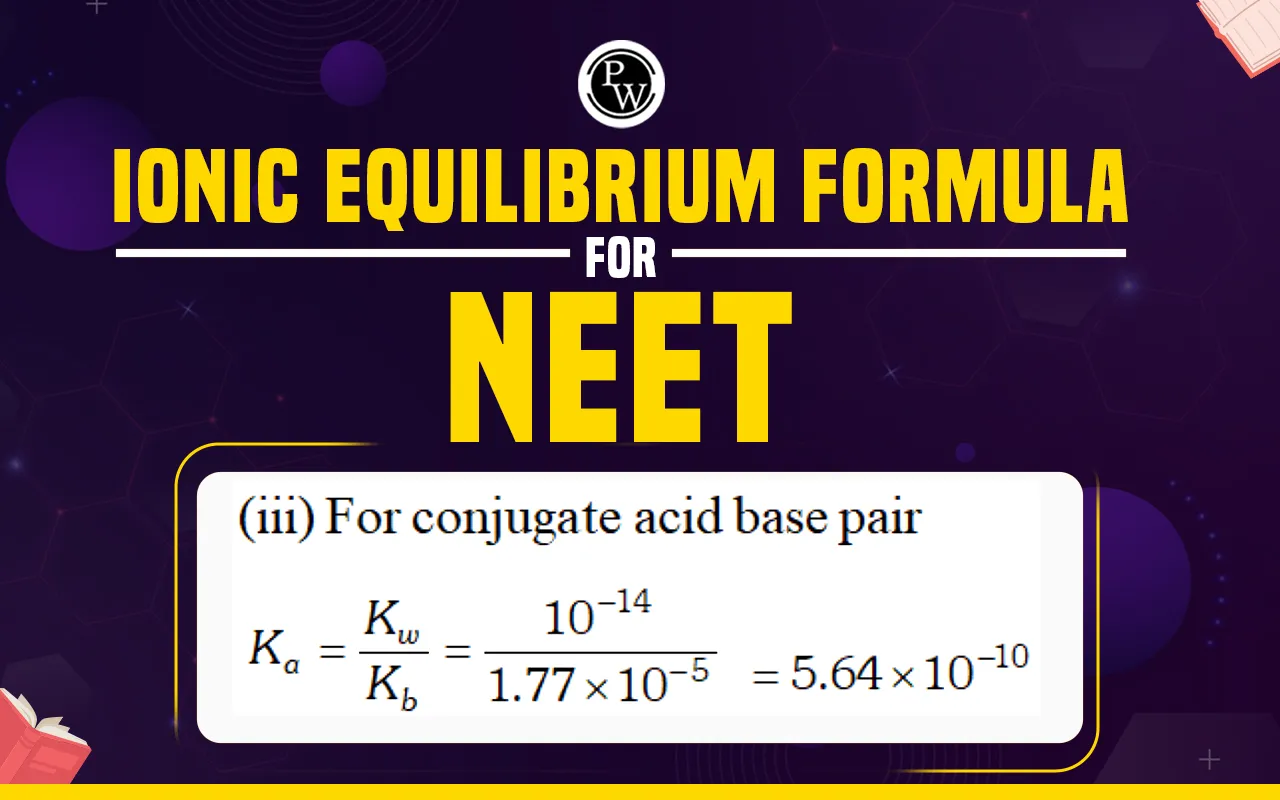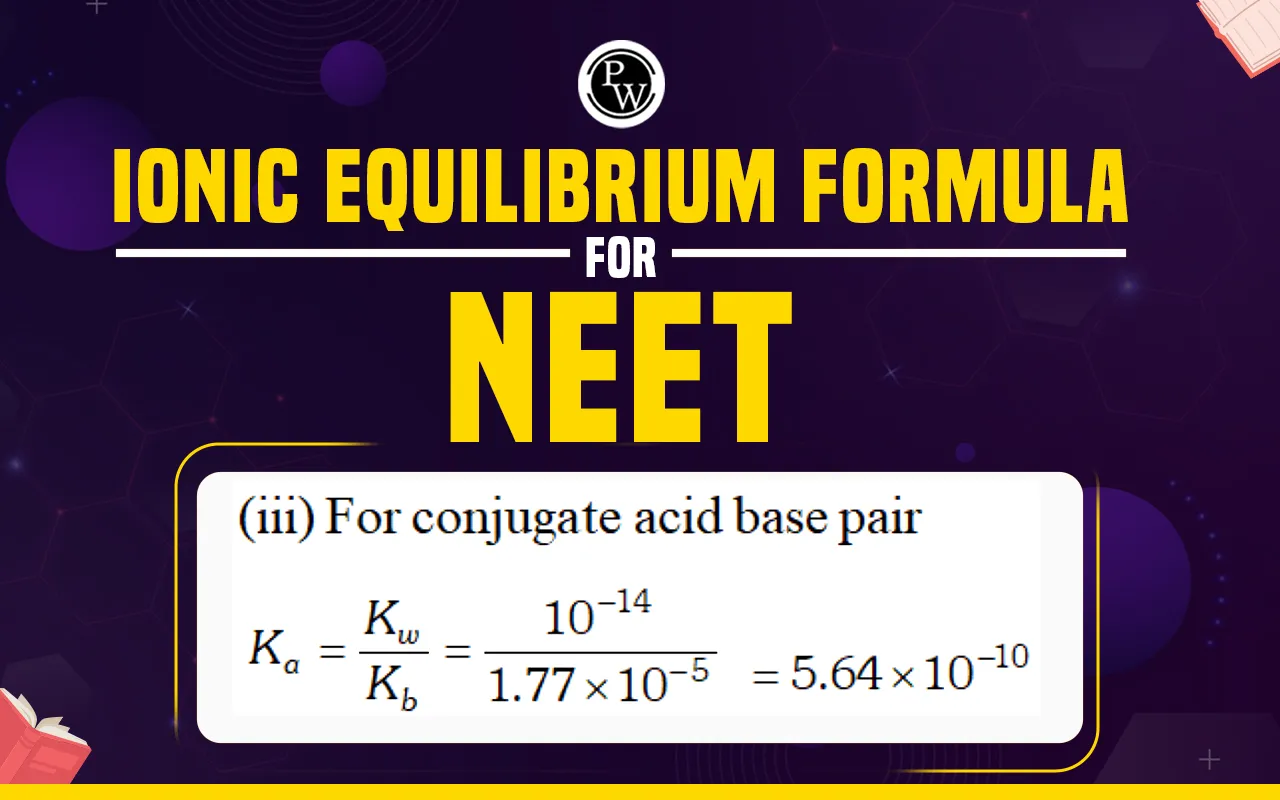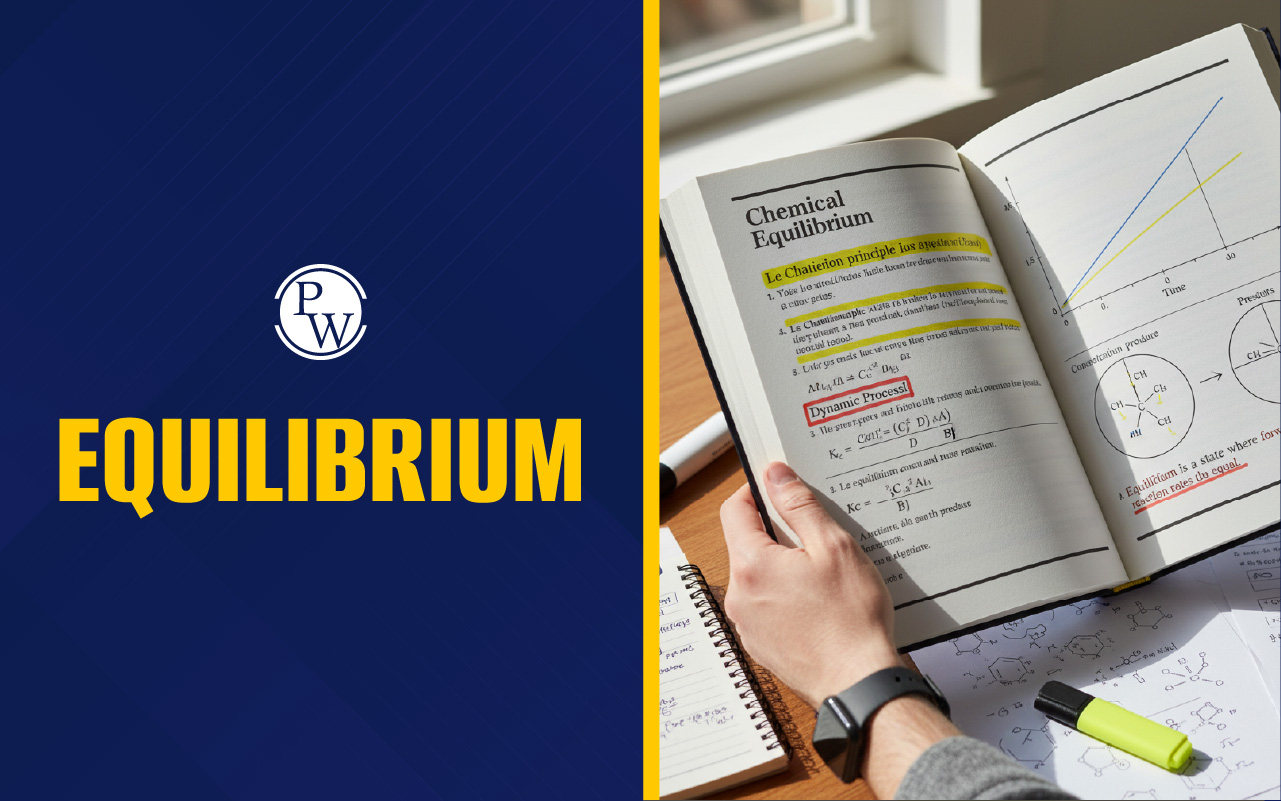

Ionic Equilibrium Formula : Ionic equilibrium addresses the balance of ions in a solution, crucial for understanding weak acids and bases. The ionization constants (Ka for acids and Kb for bases) quantify ionization extents. Ka reflects the ionization of a weak acid HA, while Kb relates to a weak base B ionizing in water.
NEET Aspirants must go through it and practice the relevant questions to this. this way can comprehensively cover the NEET 2025 syllabus .Ionic Equilibrium Formula
Ionic Equilibrium Formula has parameters, which predict pH or pOH. The Henderson-Hasselbalch equation connects pH, Ka, and the ratio of conjugate base to weak acid concentrations in buffers. Getting ionic equilibrium is essential for explaining substance behavior in solutions without forming strong chemical bonds.Ostwald Dilution Law
The Ostwald Dilution Law describes the relationship between the degree of dissociation (α) of a weak electrolyte and its concentration when diluted. For a weak electrolyte AB dissociating into ions A^z+ and B^w-, the law is given by:α = sqrt(Kc / C)
Where:- α is the degree of dissociation.
- K_c is the equilibrium constant for the dissociation.
- C is the initial concentration of the weak electrolyte.
Ionization Constant (Ka for acids, Kb for bases)
The ionization constant, denoted as Ka for acids or Kb for bases, measures how much a weak acid or base ionizes in a solution. It's crucial in studying ionic equilibrium in aqueous solutions.- Acid Ionization Constant (Ka): For a weak acid (HA) dissociating in water: HA ⇌ H⁺ + A⁻ The acid ionization constant is given by: Ka = [H⁺][A⁻] / [HA]
- Base Ionization Constant (Kb): For a weak base (B) reacting with water: B + H₂O ⇌ BH⁺ + OH⁻ The base ionization constant is given by: Kb = [OH⁻][BH⁺] / [B]
pH Calculation
pH is a measure of the acidity or alkalinity of a solution and is defined as the negative logarithm (base 10) of the concentration of hydrogen ions ( ) in the solution. The pH scale ranges from 0 to 14, where lower pH values indicate acidic solutions, higher pH values indicate basic (alkaline) solutions and a pH of 7 represents a neutral solution. The pH of a solution is calculated using the formula:pH = -log[H+]
pOH Calculation
The pOH is a measure of the hydroxide ion ( ) concentration in a solution and is the negative logarithm (base 10) of that concentration. It provides information about the basicity or alkalinity of a solution, analogous to how pH indicates acidity. Like pH, pOH is measured on a scale from 0 to 14, with lower values indicating more basic solutions and higher values indicating more acidic or neutral solutions. The pOH of a solution is calculated using the formula:pOH = -log[OH-]
Relation between pH and pOH in Water
This relationship highlights that the sum of the pH and pOH in a solution, at any given moment, is always equal to 14. As pH increases, pOH decreases, and vice versa, reflecting the inverse relationship between the concentrations of hydrogen ions and hydroxide ions in water. A neutral solution (pure water) has a pH of 7 and a pOH of 7, making the sum equal to 14.pH + pOH = 14
Henderson-Hasselbalch Equation
The Henderson-Hasselbalch equation is a mathematical expression that relates the pH of a solution to the pKa (acid dissociation constant) and the ratio of the concentrations of the dissociated (ionized) and undissociated (unionized) forms of a weak acid or weak base. This equation is particularly useful in understanding and calculating the pH of buffer solutions. For an acid (HA) and its conjugate base (A⁻), the Henderson-Hasselbalch equation is given by:pH = pKa + log([A-]/[HA])
For a base (B) and its conjugate acid (BH⁺), the equation is modified as follows:pOH = pKb + log([BH+]/[B])
These formulas are fundamental for understanding the behavior of weak acids and bases in solution, calculating the pH and pOH of a solution, and applying the Henderson-Hasselbalch equation to buffer systems. Ka and Kb values are specific to each acid or base, indicating the degree of ionization or dissociation. The pH and pOH calculations help quantify the acidity or basicity of a solution.Prepare for NEET with PW Online NEET Coaching! Our courses offer structured lessons, clear explanations of concepts, and interactive classes to support your NEET preparation effectively.
|
NEET Important Formulas for 2025 |
|
|---|---|
Ionic Equilibrium Formula FAQs
How to Calculate Ionic Equilibrium?
Ionic equilibrium is often calculated using the concept of equilibrium constants, such as Kc or Kp for chemical reactions. For acids and bases, the acid dissociation constant (Ka) or the base dissociation constant (Kb) is commonly used. These constants express the ratio of concentrations of products to reactants at equilibrium.
What is ionic equilibrium Class 11 example?
An example from Class 11 chemistry involves the ionization of a weak acid, like acetic acid (CH3COOH), in water:
CH3COOH ⇌ CH3COO- + H+
This equation represents the dynamic equilibrium between the undissociated acid and its dissociated ions in a solution.
What is Ka in ionic equilibrium formula?
Ka is the acid dissociation constant, a measure of the strength of an acid in a solution. It is defined as the ratio of the concentrations of the dissociated ions (products) to the undissociated acid (reactant) at equilibrium. The Ka expression for acetic acid (CH3COOH) is given by:
Ka = [CH3COO-][H+]/[CH3COOH]
What is the formula of equilibrium?
The general formula for an equilibrium reaction, representing the dynamic balance between reactants and products, is given by:
aA + bB ⇌ cC + dD
Here, A and B are reactants, C and D are products, and 'a', 'b', 'c', and 'd' are the stoichiometric coefficients. The equilibrium constant (K) expression for this reaction is given by:
K = [C]c[D]d/[A]a[B]b
Talk to a counsellorHave doubts? Our support team will be happy to assist you!

Check out these Related Articles
Free Learning Resources
PW Books
Notes (Class 10-12)
PW Study Materials
Notes (Class 6-9)
Ncert Solutions
Govt Exams
Class 6th to 12th Online Courses
Govt Job Exams Courses
UPSC Coaching
Defence Exam Coaching
Gate Exam Coaching
Other Exams
Know about Physics Wallah
Physics Wallah is an Indian edtech platform that provides accessible & comprehensive learning experiences to students from Class 6th to postgraduate level. We also provide extensive NCERT solutions, sample paper, NEET, JEE Mains, BITSAT previous year papers & more such resources to students. Physics Wallah also caters to over 3.5 million registered students and over 78 lakh+ Youtube subscribers with 4.8 rating on its app.
We Stand Out because
We provide students with intensive courses with India’s qualified & experienced faculties & mentors. PW strives to make the learning experience comprehensive and accessible for students of all sections of society. We believe in empowering every single student who couldn't dream of a good career in engineering and medical field earlier.
Our Key Focus Areas
Physics Wallah's main focus is to make the learning experience as economical as possible for all students. With our affordable courses like Lakshya, Udaan and Arjuna and many others, we have been able to provide a platform for lakhs of aspirants. From providing Chemistry, Maths, Physics formula to giving e-books of eminent authors like RD Sharma, RS Aggarwal and Lakhmir Singh, PW focuses on every single student's need for preparation.
What Makes Us Different
Physics Wallah strives to develop a comprehensive pedagogical structure for students, where they get a state-of-the-art learning experience with study material and resources. Apart from catering students preparing for JEE Mains and NEET, PW also provides study material for each state board like Uttar Pradesh, Bihar, and others
Copyright © 2025 Physicswallah Limited All rights reserved.
Get App












